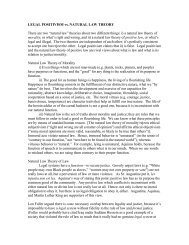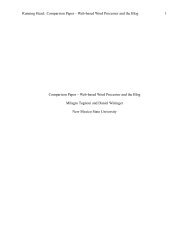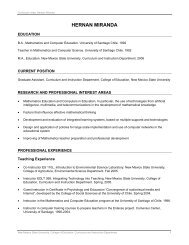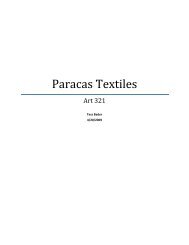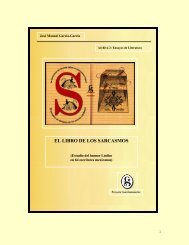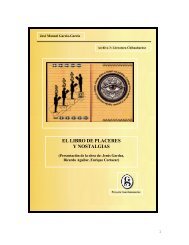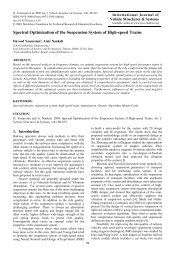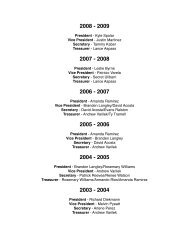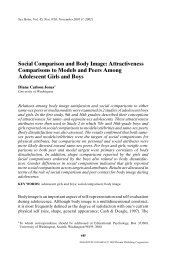The Origins of a Free Press in Prerevolutionary ... - Web Publishing
The Origins of a Free Press in Prerevolutionary ... - Web Publishing
The Origins of a Free Press in Prerevolutionary ... - Web Publishing
You also want an ePaper? Increase the reach of your titles
YUMPU automatically turns print PDFs into web optimized ePapers that Google loves.
Both the Maryland Gazette and the Virg<strong>in</strong>ia Gazette evolved <strong>in</strong> size and<br />
typeface and now conta<strong>in</strong>ed more news and advertis<strong>in</strong>g. <strong>The</strong> earliest gazettes<br />
consisted <strong>of</strong> four pages, each about seven and a half <strong>in</strong>ches wide by twelve and a<br />
quarter <strong>in</strong>ches high, with two columns <strong>of</strong> pr<strong>in</strong>t. Although the actual page size,<br />
columns, and type size would vary with availability <strong>of</strong> paper and type, the size and<br />
number <strong>of</strong> words generally <strong>in</strong>creased with time. By the 1760s, the normal page size<br />
was about fifteen by eleven <strong>in</strong>ches, a considerable space <strong>in</strong>crease <strong>of</strong> about eighty<br />
percent. In addition, the pr<strong>in</strong>ter <strong>of</strong>ten used a smaller type font and used three and<br />
sometimes four columns, allow<strong>in</strong>g for more stories and advertisements. 50 <strong>The</strong><br />
number <strong>of</strong> pages stayed consistent at four, but the pr<strong>in</strong>ters published additional<br />
issues, or “supplements” to the weekly paper more <strong>of</strong>ten. With a local supply <strong>of</strong><br />
paper, that expensive commodity became more readily available, and supplemental<br />
issues would also be pr<strong>in</strong>ted to <strong>in</strong>clude <strong>in</strong>creased news and ads. 51<br />
Newspaper advertisements were an <strong>in</strong>creas<strong>in</strong>gly important part <strong>of</strong> the<br />
Chesapeake pr<strong>in</strong>ters’ bus<strong>in</strong>ess and the ads and the newspapers that ran them were<br />
part <strong>of</strong> an important cultural shift towards consumerism. <strong>The</strong> ads took an<br />
<strong>in</strong>creas<strong>in</strong>gly larger percentage <strong>of</strong> the available space <strong>in</strong> the newspaper, even as the<br />
overall number <strong>of</strong> words pr<strong>in</strong>ted <strong>in</strong>creased. Both newspapers sometimes carried<br />
50 Orig<strong>in</strong>ally, they consisted <strong>of</strong> two columns per page, but later some versions expanded to<br />
three columns, or even four columns, with a smaller type. Parks orig<strong>in</strong>ally used a Dutch type font,<br />
but eventually switched to the more readable Caslon font. <strong>The</strong> most eye-catch<strong>in</strong>g aspect <strong>of</strong> both <strong>of</strong><br />
these type fonts, to the modern reader, is the lower case “s” as <strong>in</strong> “s.” <strong>The</strong> ascend<strong>in</strong>g “s” was used<br />
only <strong>in</strong> the middle and end <strong>of</strong> sentences, not at the beg<strong>in</strong>n<strong>in</strong>g, and was generally differentiated<br />
from an f by hav<strong>in</strong>g only a half crossbar or none at all. It rema<strong>in</strong>ed <strong>in</strong> use until about 1800. See<br />
Parke Rouse, Jr., <strong>The</strong> Pr<strong>in</strong>ter <strong>in</strong> Eighteenth-Century Williamsburg: An Account <strong>of</strong> His Lie & Times, &<br />
<strong>of</strong> His Craft (Williamsburg: Colonial Williamsburg Foundation, 1955; repr<strong>in</strong>t, ed. Thomas K.<br />
Ford, 2001), i, ii, and 5. (Page citations are to the repr<strong>in</strong>t edition).<br />
51 A newly discovered copy <strong>of</strong> Virg<strong>in</strong>ia Gazette (Williamsburg: Joseph Royle. July 6, 1764) <strong>in</strong><br />
Special Collections, John D. Rockefeller, Jr. Library, Colonial Williamsburg Foundation, has<br />
three columns. By 1754, Jonas Green’s Maryland Gazette had three columns, by 1767, William<br />
R<strong>in</strong>d’s Virg<strong>in</strong>ia Gazette used smaller type and had four columns on each page. See also see<br />
Lawrence Wroth, <strong>The</strong> Colonial Pr<strong>in</strong>ter. 2 nd ed. (Portland, ME: Southworth-Anthoensen <strong>Press</strong>,<br />
1938; repr<strong>in</strong>t, New York: Dover Publications, 1994), 279-280. On paper, see Ibid., 89-133. Parks<br />
produced the paper locally beg<strong>in</strong>n<strong>in</strong>g <strong>in</strong> 1743.<br />
77



